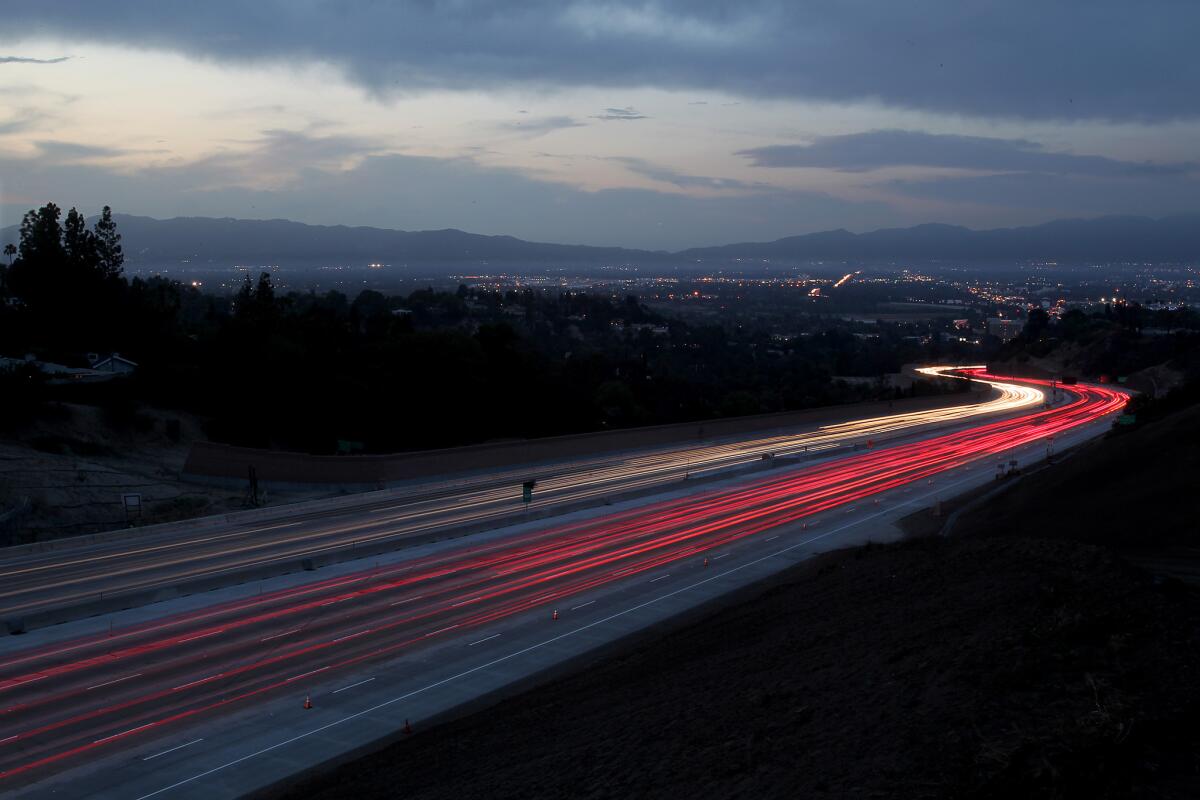Five rail lines Metro could build with $120 billion in new sales tax revenue

Metro officials are considering a tunnel for a toll freeway and a rail line that could offer relief from the infamous traffic of the 405 Freeway through the Sepulveda Pass.
- Share via
A bill that Gov. Jerry Brown signed Wednesday will allow Los Angeles County transportation officials to seek a sales tax increase in 2016 that could raise as much as $120 billion for local roads, freeways and mass transit.
If the Metropolitan Transportation Authority decides to pursue a ballot measure, voters would probably be asked to raise the county’s overall sales tax rate to 9.5%. The measure would need a two-thirds majority to pass.
The electorate has approved raising taxes three times to pay for transportation projects: in 1980, 1990 and 2008. The most recent levy, known as Measure R, provided much of the funding for new rail lines to Santa Monica and Azusa and a subway beneath Wilshire Boulevard.
------------
FOR THE RECORD
Oct. 8, 9:17 a.m.: An earlier version of this article stated that Los Angeles County voters approved sales tax increases for transportation projects in 1981 and 1991. The measures were approved in 1980 and 1990, but took effect the following years.
------------
Extending Measure R for nearly two more decades, and adding a new sales tax with a lifespan of at least 40 years, could raise $120 billion in new revenue, according to agency projections.
A poll conducted earlier this year and funded by Metro suggests that more than two-thirds of county residents would support such a measure. Nearly two-thirds of poll respondents said improvements to streets or freeways were their top priority. About one-fourth preferred light-rail and bus projects.
Here are five projects that Metro has studied and could be included in such a ballot measure. The project list will be finalized in six to nine months.
Tunnel through the Sepulveda Pass
For years, country transportation officials have discussed an ambitious alternative to the misery of the 405 Freeway: A tunnel through the Santa Monica Mountains, stretching from the San Fernando Valley to Los Angeles International Airport.
With an estimated price tag of $10 billion to $33 billion, the tunnel would be one of the most expensive public works projects in Los Angeles County history.
It could include a toll road and a rail line, connecting with the Orange Line busway in Woodland Hills, the Expo Line in West L.A. and the Green Line near LAX.
Some transportation officials see the tunnel as a strong candidate for a public-private partnership. A global firm would probably shoulder a significant portion of the construction costs, in exchange for a share of the revenue from the toll operations.
Subway extension to Santa Monica
The $2.3-billion Purple Line project, currently under construction, will extend the subway from its terminus in Koreatown to the Department of Veterans Affairs’ campus in West Los Angeles.
But the rail line, once known as the “Subway to the Sea,” will stop 6 miles short of Santa Monica. With extra money, Metro could close that gap.
In a recent agency poll, 62% of Westside residents surveyed said they would be more likely to support the ballot measure if the West L.A.-to-Santa Monica extension were included.
Rail connection to LAX
Plans are already underway to close the 2-mile gap between the county’s rail network and Los Angeles International Airport, but Metro has identified just $330 million of the estimated $1.5-billion price tag.
The “people-mover” project would probably resemble the terminal trains in use at other major U.S. airports, including San Francisco and Denver. It would carry passengers from a rail station on 96th Street to a consolidated car rental facility, a transit hub and LAX’s central terminal area.
Rail connection in Mid-City
One common complaint with the Metro rail network is that it’s easier to travel from east to west than it is from north to south.
Metro officials are considering a 6-mile extension that would run north and south through Hollywood and the Mid-City area, according to agency polling. The route would start at a Metro Red Line station in Hollywood and run south, connecting with the Wilshire Boulevard subway and the Exposition and Crenshaw lines in Baldwin Hills/Crenshaw.
Nearly 80% of Central Los Angeles residents questioned in the poll said they would be more likely to support the ballot measure if it funded such a project.
A San Fernando Valley rail line
Some elected officials and advocates argue that Los Angeles County’s rail-building boom over the last three decades has shortchanged the Valley, home to nearly 20% of county residents. The sprawling and largely built-out suburb, with its own large employment and commercial centers, has just two of Metro’s 80 rail stations.
The most sophisticated transit option in the area is the Orange Line, a dedicated busway that carries 30,000 riders a day between Chatsworth, Warner Center and North Hollywood.
Converting it to a rail line would cost $1.2 billion to $1.7 billion, according to early estimates, and would shave about 15 minutes off the trip from Warner Center to the North Hollywood Red Line subway station.
For more transportation news, follow @laura_nelson on Twitter.
ALSO:
Metrolink will improve four rail crossings in Moorpark, Simi Valley
Gov. Brown signs bill opening door to tax increase for L.A. County transit
Metro receives average rating in statewide evaluation of rail transit stations
More to Read
Sign up for Essential California
The most important California stories and recommendations in your inbox every morning.
You may occasionally receive promotional content from the Los Angeles Times.











